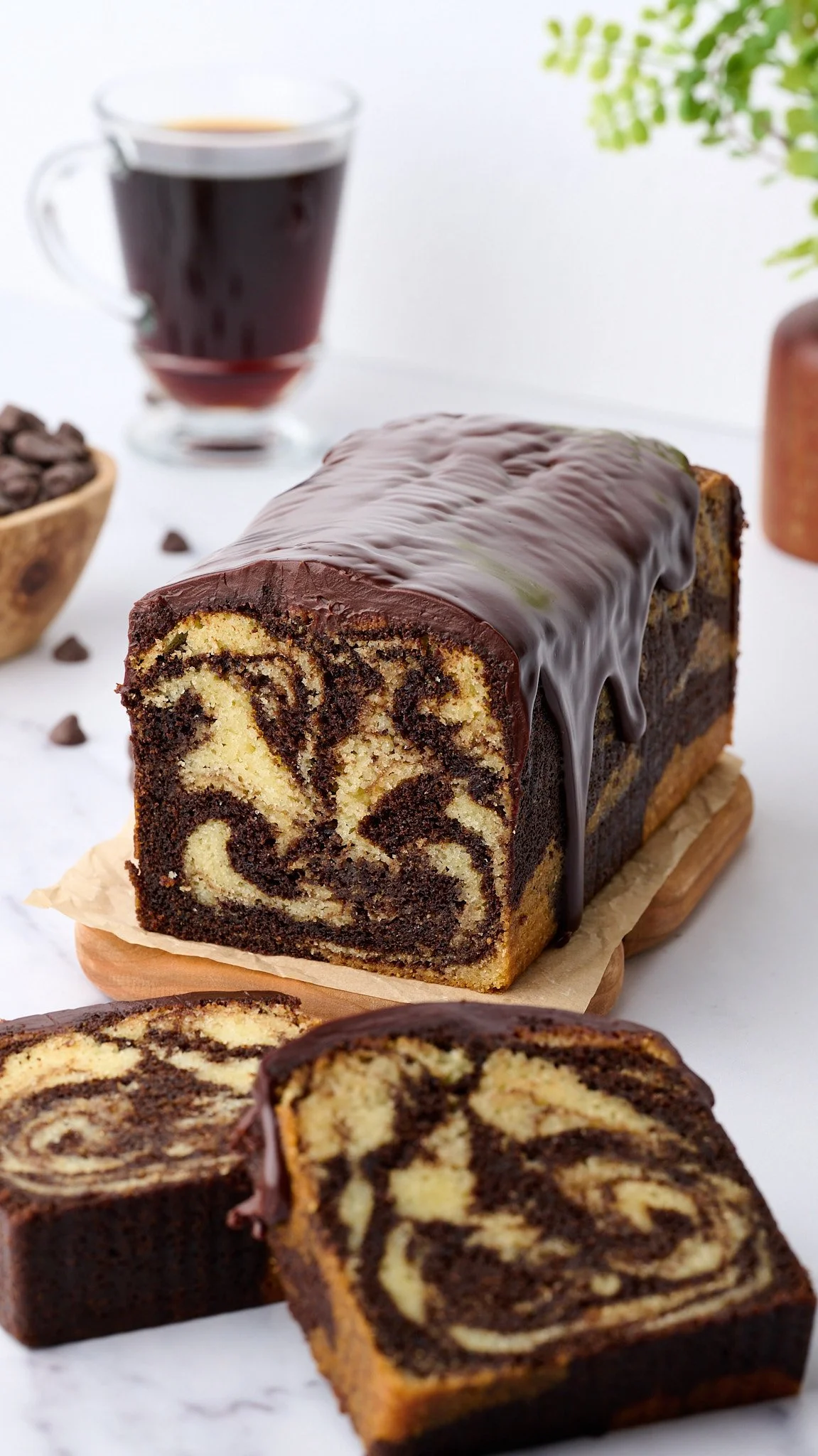Mocha Marble Pound Cake
Makes one 9" x 5" loafI love chocolate and coffee individually, but together, they bring out the best in each other.
I’ve always gravitated towards quick breads like pound cake, and a classic chocolate-and-vanilla marble loaf is no exception. In this version, we boost both moisture and tenderness with buttermilk and sour cream, then fold a mocha paste—made from Dutch cocoa, espresso powder, and hot coffee—into half the batter. It brings richness and depth that’s bold, bittersweet, and unmistakably mocha.
Swirled in a checkerboard pattern, the batters bake into a loaf that’s just as beautiful as it is delicious. And to push the mocha even further, we finish it with a simple coffee ganache.
Note: In these photos, the loaf was baked in a Pullman pan rather than a standard loaf pan. If you’d like to do the same, increase the recipe by 20–25% and extend the bake time by 10-15 minutes.
WHAT YOU’LL NEED
INGREDIENTS
Pound Cake
1 ½ cups all-purpose flour (195 g)
1 ½ tsp baking powder (7 g)
¼ tsp baking soda
1 ¼ tsp Diamond Crystal kosher salt (or ¾ tsp Morton kosher salt)
½ cup sour cream, room temp (126 g)
5 tbsp buttermilk, room temp (70 g)
1 ½ tsp vanilla extract
8 ½ tbsp unsalted butter, room temp (120 g)
4 tbsp neutral oil, like canola or grapeseed (55 g)
1 ¼ cups granulated sugar (252 g)
3 large eggs, room temp
Mocha Paste
2 ½ tbsp Dutch-process cocoa powder (20 g)
1 ½ tbsp instant espresso powder (7 g)
2 tbsp hot brewed coffee (30 ml)
Coffee Ganache
4 oz semi-sweet chocolate, chopped (120 g)
100 ml (scant ½ cup) heavy cream
1 tsp instant espresso powder
Pinch of kosher salt
DIRECTIONS
Make the Pound Cake Batter
Grease and line a 9×5" loaf pan with parchment, leaving overhang on the long sides. Preheat oven to 325°F (163°C).
In a medium bowl, whisk together the flour, baking powder, baking soda, and salt. Set aside.
In another bowl, whisk together the sour cream, buttermilk, and vanilla until smooth. Set aside.
In a stand mixer fitted with the paddle attachment (or using a hand mixer), beat the butter, oil, and sugar on medium-high speed for 4 minutes, until light and fluffy.
Add the eggs one at a time, mixing 20–30 seconds after each addition. Scrape down the bowl as needed.
With the mixer on low speed, alternate adding the dry and wet ingredients in three additions, beginning and ending with the dry. Mix just until everything is incorporated.
Divide the Batter & Bake
In a small bowl, whisk together the cocoa powder, espresso powder, and hot coffee into a smooth paste.
Divide the batter in half. Mix the mocha paste into one half, stirring until fully incorporated with no streaks.
In the prepared pan, alternate spoonfuls of vanilla and mocha batter in a checkerboard-style pattern. Once all the batter is added, swirl with a knife or offset spatula in a figure-eight motion.
Bake for 60-70 minutes, or until a toothpick inserted into the center comes out clean. Cool in the pan for 15 minutes, then transfer to a wire rack to cool completely, about 1 hour.
Make the Coffee Ganache
Place the chopped chocolate in a medium heatproof bowl.
In a small saucepan, whisk together the heavy cream, espresso powder, and a pinch of salt. Heat over medium until steaming but not boiling.
Pour the hot cream over the chocolate. Let sit undisturbed for 2 minutes, then gently stir until smooth and glossy.
Pour over the cooled loaf. Let the ganache set slightly before slicing and serving.
RECIPE NOTES & TIPS
Wrap well and store in an airtight container at room temperature for up to 3 days. To freeze, wrap the fully cooled loaf tightly in plastic wrap and then foil. Freeze for up to 2 months.
Use a long serrated knife and clean between cuts for neat slices, especially before the ganache is set.
To help the cake bake evenly, make sure your eggs, butter, buttermilk, and sour cream are at room temperature before mixing the batter.
To be precise and consistent when baking, I recommend using a Digital Food Scale. The one I linked is relatively inexpensive and in my opinion, a great investment for any home kitchen! But if you don’t have one, I’ll always include cup measurements as well.
You can also listen to your cake to tell when it’s done. If you place your ear near the cake (carefully—don’t burn yourself), you should hear a soft, slow bubbling sound. Fast bubbling? It’s not done yet. Completely silent? It’s likely slightly over-baked. It takes a bit of practice, but listening for those sounds at different stages of baking can help you get a better feel for it.






